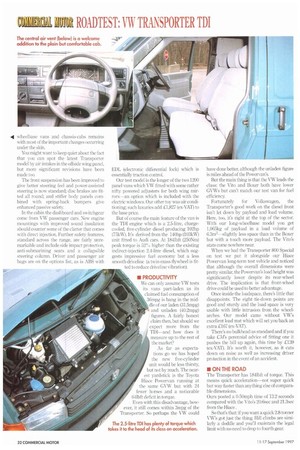wheelbase vans and chassis-cabs remains with most of the important changes occurring under the skin.
Page 34

If you've noticed an error in this article please click here to report it so we can fix it.
You might want to keep quiet about the fact that you can spot the latest Transporter model by air intakes in the offside wing panel. but more significant revisions have been made too.
The front suspension has been improved to give better steering feel and power-assisted steering is now standard; disc brakes are fitted all round; and stiffer body panels combined with spring-back bumpers give enhanced passive safety.
In the cabin the dashboard and switchgear conic from VW passenger cars. New engine mountings with improved sound insulation should counter some of the clatter that comes with direct injection. Further safety features, standard across the range, are fairly unremarkable and include side impact protection, a mi.submarining seats and a collapsible steering column. Driver and passenger air bags are on the options list, a! is \fl w.
EDL (electronic differential lock) which is essentially traction control.
Our test model is the longer of the two 1200 panel vans which VW fitted with some rather nifty powered adjusters for both wing mirrors—an option which is included with the electric windows. Our other toy was air conditioning; such luxuries add £1 827 (ex-VAT) to the base price.
But of course the main feature of the van is the TDI engine which is a 2.5-litre, chargecooled, five-cylinder diesel producing 102hp (75kW). It's derived from the 140hp (103kW) unit fitted to Audi cars. At 1841bft (250Nm) peak torque is 520 higher than the existing indirect-injection 2.4-litre diesel, which suggests impressive fuel economy but a less smooth driveline (a twin-mass flywheel is fit ted to reduce driveline vibration).
We can only assume VW tests its vans part-laden as its claimed fuel consumption of 36mpg is bang in the middle of our laden (31.5mpg) and unladen (40.2mpg) figures. A fairly honest claim then, but should we expect more from the TDI—and how does it measure up to the rest of the market?
As far as expectations go we has hoped the new five-cylinder unit would be less thirsty, but not by much. The nearest yardstick is the Toyota Hiace Powervan running at the same GVW but with 24 fewer horses and a noticeable 1341bft deficit in torque.
Even with this disadvantage, however, it still comes within 3mpg of the Transporter. So perhaps the VW could have done better, although the unladen figure is miles ahead of the Powervan's.
But the main thing is that the VW leads the class: the Vito and Boxer both have lower GVWs but can't match our test van for fuel efficiency.
Fortunately for Volkswagen, the Transporter 's good work on the diesel front isn't let down by payload and load volume. Here, too, its right at the top of the sector. With our long-wheelbase triodel you get 1,065kg of payload in a load volume of 6.3m3—slightly less space than in the Boxer but with a touch more payload. The Vito's stats come nowhere near.
When we had the Transporter 800 Special on test we put it alongside our Hiace Powervan long-term test vehicle and noticed that although the overall dimensions were pretty similar, the Powervan's load height was significantly lower despite its rear-wheel drive. The implication is that front-wheel drive could be used to better advantage.
Once inside the loadspace, there's little that disappoints. The eight tie-down points are goad and sturdy and the load space is very usable with little intrusion from the wheelarches. Our model came without VW's excellent load mat which will set you back an extra £167 (ex-VAT).
There's no bulkhead as standard and if you take GM's perennial advice of fitting one it pushes the bill up again, this time by £139 (ex-VAT). It's worth it, however, as it cuts down on noise as well as increasing driver protection in the event of an accident.
The Transporter has 1841bft of torque. This means quick acceleration—not super quick but way faster than anything else of comparable dimensions.
Ours posted a 0-50mph time of 13.2 seconds compared with the Vito's 20.6sec and 21.3sec from the Hiace So that that: if you want a quick 2.8-former VVV's got just the thing. Hill climbs are similarly a doddle and you'll maintain the legal limit with no need to drop to fourth gear.


























































































































